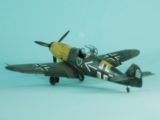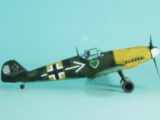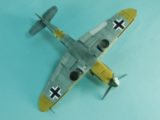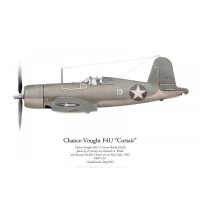1/48 Eduard Bf-109F-2 – Hannes Trautloft
Hannes Trautloft and JG 54
Born March 3, 1912, Johannes "Hannes" Trautloft was among the pilots given special fighter training before the Luftwaffe was revealed. He started flight training in April 1931 at the Deutsche Verkehrfliegerschule (German Air Transport School) at Schleißheim with 29 other trainees in Kameradschaft 31, abbreviated "K 31," a course that included Wolfgang Falck and Günther Lützow. Graduating with his wings in February 1932, he and nine others were recommended for “special training” at the secret fighter pilot school in Lipetsk, USSR. Upon completion, he was promoted to Leutnant and became one of the original members of the Luftwaffe when its existence was revealed in 1935.
Trautloft was one of the six original Luftwaffe pilots sent to Spain in August 1936 with six Heinkel He-51 fighters to train pilots for Franco's Nationalist Air Force. Taking up combat duties while the Spaniards continued to train, Trautloft shot down a Republican Breguet-19 on August 25, 1936, as the first aerial victory for a German pilot since 1918. On August 30 he shot down a Potez-54, and was in turn shot down himself, crash-landing and making his way back to Nationalist lines; thus he was also the first German pilot to be shot down in combat since 1918.
When the He-51 proved itself no match for the Soviet I-15 and I-16 fighters, three prototype Bf-109As were sent to Spain, and Trautloft converted to the new fighter, scoring three more victories in Spain. He adopted the Green Heart symbol of his native Thuringia as his personal insignia at this time.
Returning to Germany, he held various squadron leader commands. On September 1, 1939, he was Staffelkapitän of 2./JG 77, which he led through the Polish campaign, scoring one victory. He was promoted to Hauptmann and appointed Gruppenkommandeur of I./JG 20 on September 19. He led the unit during the Battle of France in Mauy and June, 1940. The unit became II/JG 51 on July 1 and he led it in the Battle of Britain in August where he scored two more victories. On August 25, he was one of several young Gruppenkommandeur jumped up to Geschwaderkommodore, taking command of JG 54, which he led through the rest of the battle, during which he scored three more victories for a total of 13.
JG 54 was transferred to the Balkans in March 1941 and took part in the Balkans Campaign. They were assigned to the Northern Group on the Eastern Front for Operation Barbarossa. By June 27, 1941, Trautloft was awarded the Knight's Cross for 20 victories and outstanding leadership of the Geschwader. JG 54 would be stationed on the Leningrad Front for the next two years. In December 1941 he ordered the Green Heart of Thuringia to become the fficial Geschwader symbol and JG 54 became known thereafter as the Grünherz-Geschwader. Trautloft was a popular leader during this period, and by July 1943 his score was 58.
On July 6, 1943, Trautloft was promoted by General der Jagdflieger Adolf Galland to become Jagdflieger Inspizient Ost, which put him in overall charge of all Jagdgeschwadern on the Eastern Front. In November 1943 he was promoted to Inspekteur der Tagjäger, responsible for all German day fighter units during the coming “Battle of Germany” in 1944.
In January 1945 Trautloft joined Galland and other high-ranking pilots in the "Fighter Pilots Revolt", protesting the squandering of Luftwaffe fighters and pilots in high-loss operations like Case Bodenplatte. Following this, Trautloft was relieved as Inspekteur der Tagjäger and sent to command 4 Flieger-Schule Division (4th Pilot School Division) in Strasburg, where he spent the remainder of the war.
Trautloft joined the new Bundesluftwaffe in 1955 and served until 1970, retiring as a Generalleutnant. He died in 1995.
During its time on the northern front, JG 54 made major experiments with more effective aircraft camouflage than the standard 74/75/76 which was not suited for combat over the vast forests of northern Russia, with the result that the Bf-109s and Fw-190s used by the unit were more distinctively painted than any other Luftwaffe fighters.
Eduard's Bf-109F-4 was released in 2016 as a follow-up to their re-released Bf-109G-6, released in 2015. The kit easily qualifies as the best Bf-109F kit in 1/48, unless one desires to open up the cowling and display the DB 601 engine, in which case the kit to get is the excellent Zvezda version.
I was able to pick up the long-lost Aeromaster Special sheet, SPA 48-02, Jadgefeschwader 54 Greenhearts, which provides personal markings for Bf-109E/F/G aircraft and Fw-190s flown by the second highest-scoring Luftwaffe Geschwader. The Bf-109F-2 flown by Geschwader Kommodore Hannes Trautloft is one of the most colorful.
This is essentially a decal review more than a kit construction review.
It is not hard to modify the Eduard kit to a Bf-109F-2. One merely needs to use the smaller air intake on the cowling and the smaller tailwheel. I also modified the seat to an earlier version with a complete seat back, using Evergreen sheet. The kit goes together easily and the result is a good-looking model.
Aeromaster would have one use Sandgelb RLM79 and RLM70 for the non-standard camouflage. Jerry Crandall's later research calls for a non-standard light green (which might have been Russian “tractor green”) and RLM70. I chose to use Tamiya XF-27 “Black Green” and XF-65 “Field Green” on this model.
I first painted the yellow areas, then masked them off, then freehanded the camouflage, doing a bit of “post shading” with each. Given the airplane belonged to the Kommodore, I did not do a lot of weathering to the scheme. I gave the model a coat of Xtracrylix Clear Gloss and was ready for the decals.
The Aeromaster decals needed a couple of applications of Solvaset to go down. I used a separate Aeromaster sheet for the swastika.
I applied exhaust stains with Tamiya “Smoke,” then attached the landing gear and prop, and opened the canopy.
I think one of the reasons Luftwaffe fighters are so popular with modelers is because of the plethora of camouflage schemes and markings they can be done in. Trautloft's scheme is far more colorful than the scheme it replaced, and the model looks very distinctive lined up with the other excellent Eduard 109s. The Friedrich is my favorite 109 and I really like this Eduard kit. I've purchased several of the overtrees sets, so look for more colorful Greenhearts in the future.















Love the model. Jg.54 is my favorite for for all the odd schemes they produced
A Bf-109...? Ya don't see too many of those built on any modeling forums.
I've still got a new one in the box...guess I better get another one then.
You can't build just one of the Eduards.
What George said! They went their own way, out on the steppes away from HQ.
Tom, first rate build and paint job. Looks the part.
Great subject, and now... I've got to go pick one up ... Thanks Tom...
Seriously, another great build, and not the same old Camo.
Certainly one of the more colourful ME 109s and must look great lined up with the others. Maybe you need a drop more Solvaset on the swastikas?
No. The scheme was field applied, and they painted around the swastikas, which were on the light blue background, so you see a light background immediately behind them. All intentional.
Ah, fair enough.
Your 109 looks fantastic. I never noticed the yellow leading edges of the wings before now. JG 54 is my favorite Luftwaffe unit, partly due to the vast assortment of "non standard" paint schemes.
That was Jerry Crandall's research. A couple years ago.
The F versions are better looking than what followed, as they added bumps and bulges to try to keep up with the opposition. Kinda the last of the sportin' models...
The Friedrich was the best combination of engine and airframe. Heinxz Knoke (in his autobiography "I Flew For The Fuhrer") commented that the Gustav had to be flown at full throttle in the landing pattern. Not a good sign.
Tom, thanks for the review. If I was only to build one "F" in this scale, would you recommend the Zvezda or Eduard kit? The Zvezda kit can be obtained very cheaply, and with everything that I've read about it, I'm tempted - but just wanted to see if there are any disadvantages. Except decals, which I intend replacing anyway. Thanks. PS. I also like the "F" for its pure elegance.
It depends on what you want. Both kits are excellent. The Zvezda is a bit more "fiddly" in construction. It gives you a complete engine, so you can display it with the cowling open, as I did in my review at Modeling Madness. Or you can close it up. Here are both reviews:
http://modelingmadness.com/review/axis/cleaver/g/tc109f2.htm
http://modelingmadness.com/review/axis/cleaver/g/tc109f4.htm
While I don't have the Eduard (so far, Saints preserve us) Zvesda is a beaut. Agree about the decals, they have an F2 and 4, and options.
Buy with confidence.
Another nice build Tom! Colorful schemes are always a bonus.
nice
Beautiful! Also, thanks for the links to your Zvezda reviews on the M/M site.